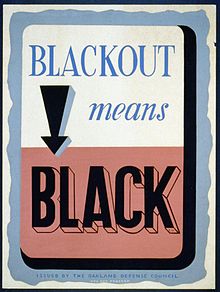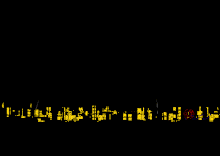
A blackout during war, or in preparation for an expected war, is the practice of collectively minimizing outdoor light, including upwardly directed (or reflected) light. This was done in the 20th century to prevent crews of enemy aircraft from being able to identify their targets by sight, such as during the London Blitz of 1940. In coastal regions, a shoreside blackout of city lights also helped protect ships from being seen silhouetted against the artificial light by enemy submarines farther out at sea.
World War I
United Kingdom
Plans to black out British coastal towns in the event of war were drawn up in 1913 by Winston Churchill in his role as First Lord of the Admiralty; these plans were implemented on 12 August 1914, eight days after the United Kingdom had entered the war. [1] On 1 October 1914, the Commissioner of the Metropolitan Police ordered that bright exterior lights were to be extinguished or dimmed in the London area and street lamps be partially painted out with black paint. [2] Elsewhere, the matter was left to local authorities. Following the start of the German strategic bombing campaign early in 1915, ordinary people in towns without blackouts sometimes took the law into their own hands, smashing street lamps which they thought might attract an air raid. [3] Blackout restrictions were extended to the whole of England in February 1916. [4]
France
In France, a blackout was implemented for Paris at the start of the Zeppelin campaign in the spring of 1915, but was later relaxed, only to be reintroduced in the spring of 1918 when the Germans began using heavy bombers against the city. [5]
Germany
In Germany, a blackout was only enforced in a zone 150 kilometres (93 miles) behind the Western Front. [6]
World War II
United Kingdom

During World War II, the Air Ministry had forecast that Britain would suffer night air bombing attacks causing large numbers of civilian casualties and mass destruction. It was widely agreed that navigation and targeting would be more difficult if man-made lights on the ground could be extinguished. As early as July 1939, Public Information Leaflet No 2 (part of the Air Raid Precautions (A.R.P.) training literature) warned of the need for popular discipline to ensure that the blackout regulations were fully enforced during the blackout periods. [7]
Blackout regulations were imposed on 1 September 1939, before the declaration of war. These required that all windows and doors should be covered at night with suitable material such as heavy curtains, cardboard or paint, to prevent the escape of any glimmer of light that might aid enemy aircraft. The Government ensured that the necessary materials were available. [7] External lights such as street lights were switched off, or dimmed and shielded to deflect light downward. Essential lights such as traffic lights and vehicle headlights were fitted with slotted covers to deflect their beams downwards to the ground. [8]
Shops and factories had particular problems. Factories with large areas of glass roofing found it impossible to install temporary blackout panels and permanent methods (such as paint) lost natural light during daylight. Shops had to install double "airlock" doors to avoid lights showing as customers arrived and departed. [7]
Blackouts proved one of the more unpleasant aspects of the war, disrupting many civilian activities and causing widespread grumbling and lower morale. [9]
The blackout was enforced by civilian ARP wardens who would ensure that no buildings allowed the slightest peek or glow of light. [10] Offenders were liable to stringent legal penalties. [7]
Blackout restrictions greatly increased the dangers of night driving and fatalities increased as a consequence. As a result, some aspects were relaxed and speed limits were lowered. Fatalities were also recorded amongst merchant seamen falling into the docks at night and drowning during the blackout.
Crime also increased under cover of darkness, from looting, theft, burglary, robbery, fraud, and gang-related activities, to rape and murder, and even serial murder. [11]
As German war-making capability declined, a "dim-out" was introduced in September 1944, which allowed lighting to the equivalent of moonlight. A full blackout would be imposed if an alert was sounded. Full lighting of streets was allowed in April 1945; on 30 April, the day Hitler committed suicide, Big Ben was lit, 5 years and 123 days after the blackout was first imposed. [7]
United States

Since the attack on Pearl Harbor, the continental United States was exposed to air attacks while engaging in a war with Japan, such as the bombing of Dutch Harbor, the Lookout Air Raids, and the Fu-Go balloon bombs, but these were considered minor or negligible and did nothing to damage American morale and war effort. Along the Atlantic coast, the lack of a coastal blackout served to silhouette Allied shipping and thus expose vessels to German submarine attack. Coastal communities resisted the imposition of a blackout for amenity reasons, citing potential damage to tourism. The result was a disastrous loss of shipping, dubbed by German submariners as the " Second Happy Time". [12]
Effectiveness
M. R. D. Foot argues that blackouts did not impair navigation by bombers because navigators focused more on reflective bodies of water, railroad tracks, or large highways. [13]
Techniques

Lights can simply be turned off or light can sometimes be minimized by tarring the windows of large public structures. In World War II, a dark blackout curtain was used to keep the light inside. Tarring the windows can mean a semi-permanent blackout status.
During the 1940s and 1950s, cities such as Detroit would practise blackout air raid drills. During this time, the city's Civil Defense workers would immediately activate the neighborhood air raid siren and families would be required to do the following in order:
- Shut off all appliances, such as stoves, ovens, furnaces.
- Shut off valves for water and natural gas or propane, as well as disconnect electricity.
- Close blackout curtains (plain black curtains that would block light from coming in or going out). This step was changed after the atomic age began: where white curtains were used to reflect the thermal flash of the bomb, black curtains were used in World War II to prevent any airborne enemies from seeing light from windows.
- Get to a public shelter, a fallout or bomb shelter, or the household basement, and stay there until the local police or block warden dismissed the blackout. [14] [15]
Modern technology
The benefits of blackouts against air attack are now largely nullified in the face of a technologically sophisticated enemy. As early as World War II, aircraft were using radio-beam navigation (see " Battle of the Beams"), and targets were detected by air-to-ground radar, (e.g. H2X). Today, not only are night-vision goggles readily available to air crews, but sophisticated satellite-based and inertial navigation systems enable a static target to be found easily by aircraft and guided missiles. Nevertheless, during the 1991 Gulf War, authorities in Baghdad practised blackouts along with other civil defence procedures, before the Gulf War air campaign began striking the city. [16]
References
- ^ Wiggam, Marc P (March 2011). "The Blackout in Britain and Germany during the Second World War" (PDF). ore.exeter.ac.uk. University of Exeter. Retrieved 16 August 2017. (p. 51)
- ^ Castle, Ian (2015). The First Blitz: Bombing London in the First World War. Osprey Publishing. p. 18. ISBN 978-1472815293.
- ^ Wiggam p. 54
- ^ Wiggam p. 52
- ^ Gregory, Derek (20 October 2012). "Is Paris Burning?". geographicalimaginations.com. Peter Wall. Retrieved 16 August 2017.
- ^ Wiggam p. 53
- ^ a b c d e "New restrictions on the home front – Britain is blacked out!". 2 July 2006. Archived from the original on 20 March 2012. Retrieved 19 February 2011.
- ^ Barrow, Mandy (2010). "The Blackout". Britain Since the 1930s. Archived from the original on 10 February 2011. Retrieved 19 February 2011.
- ^ Robert Mackay (2002). Half the Battle: Civilian Morale in Britain During the Second World War. Manchester University Press. pp. 51–2. ISBN 9780719058943.
- ^ The activities of ARP Wardens led to ambivalent public attitudes and the catch-phrase put that light out!. The BBC sitcom "Dad's Army" includes an officious and disliked Warden.
- ^ Ellis, Mark. "10 facts about crime on the home front in the Second World War". History Extra: The official website for BBC History Magazine and BBC World Histories Magazine. Retrieved 27 March 2018.
- ^ Gannon, Michael. 1990. Operation Drumbeat: The Dramatic True Story of Germany's First U-Boat Attacks Along the American Coast in World War II. Harper and Row. ISBN 0-06-092088-2
- ^ Foot M, Dear I, eds. (1995). "Blackout". The Oxford Companion to World War II. Oxford University Press. pp. 134–135. ISBN 978-0-1986-6225-9.
- ^ "The Arsenal of Democracy". Michigan Department of Natural Resources. Michigan Historical Museum. Archived from the original on 28 December 2012. Retrieved 31 March 2015.
- ^ "MICHIGAN CIVIL DEFENSE MUSEUM, online historical museum".
- ^ Olsen, John Andreas (2003). Strategic Air Power in Desert Storm. Routledge. p. 236. ISBN 978-0714681955.
External links
![]() Media related to
Blackout in wartime at Wikimedia Commons
Media related to
Blackout in wartime at Wikimedia Commons